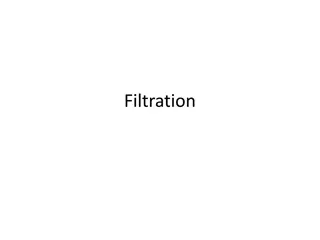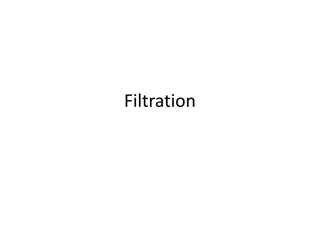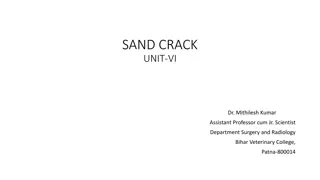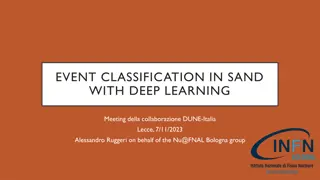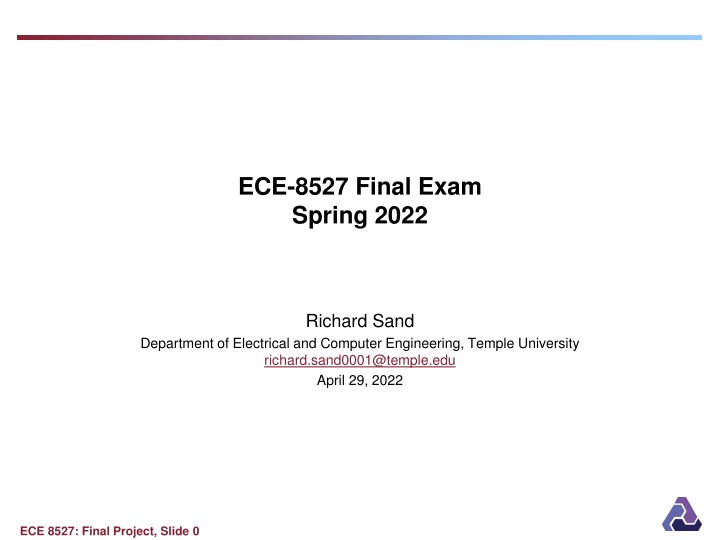
ECE 8527 Final Project Overview and Approach
Discover the intriguing data sequences and training process of the ECE 8527 final project. From understanding the data to iterating over likely events, explore the challenges and algorithms used to optimize the project's outcome.
Download Presentation

Please find below an Image/Link to download the presentation.
The content on the website is provided AS IS for your information and personal use only. It may not be sold, licensed, or shared on other websites without obtaining consent from the author. If you encounter any issues during the download, it is possible that the publisher has removed the file from their server.
You are allowed to download the files provided on this website for personal or commercial use, subject to the condition that they are used lawfully. All files are the property of their respective owners.
The content on the website is provided AS IS for your information and personal use only. It may not be sold, licensed, or shared on other websites without obtaining consent from the author.
E N D
Presentation Transcript
ECE-8527 Final Exam Spring 2022 Richard Sand Department of Electrical and Computer Engineering, Temple University richard.sand0001@temple.edu April 29, 2022 ECE 8527: Final Project, Slide 0
Project Overview Objectives: Project Overview Challenges Approach Initial Results Current State Next Steps Resources: Development Tools Helpful Articles ECE 8527: Final Project, Slide 1
Project Overview Time sequence data 5 classes, 0-5 Class 0 is background noise Visual inspection - What is this data? Low grade noisy data Noticeable spikes Spikes have varying amplitude, durations ECE 8527: Final Project, Slide 2
WHAT COULD IT BE? SETI? Underwater whale sounds? Solar radiation? Something evil that Dr. Picone dreamed up at 25 or 6 to 4? ECE 8527: Final Project, Slide 3
Understanding the data Square waveforms Little overlap Cleans up nicely! ECE 8527: Final Project, Slide 4
Training Process Identify the start and end of each event Take event duration and amplitude as 2D, classified data Preprocess data Apply learning algorithm to TRAIN Calculate error rate Adjust parameters to optimize DEV Minimize error ECE 8527: Final Project, Slide 5
Approach Iterate over training data to find likely events Normalized the data using the Zach method (patent pending) Using a window of 1, i.e. comparing the current sample to the previous, detected upward deltas over a certain % threshold (0.1) Then detected the corresponding drop to complete the event Danger Will Robinson! This approach did NOT work well on the evaluation data Train on the training dataset, tune for the dev dataset, then evaluate Two traditional (i.e. non-neural network) algorithms K-Nearest Neighbor (KNN) Random Forest (RNF) One NN approach Multilayer Perceptron (MLP) ECE 8527: Final Project, Slide 6
Algorithms - KNN KNN (K-Nearest Neighbor) Supervised classification distance from new data point to identify N nearest samples typically Euclidian distance majority vote determines classification of new data from sklearn.neighbors import KNeighborsClassifier ECE 8527: Final Project, Slide 7
Algorithms - RNF RNF (Random Natural Forest) Ensemble learning method Multiple decision trees Majority vote Varied number of estimators from sklearn.ensemble import RandomForestClassifier ECE 8527: Final Project, Slide 8
Algorithms - MLP MLP (Multilayer Perceptrons) ISIP / PyTorch / the Nabila method (patent also pending) Network with 3 layers of linear transformation (torch.nn.Linear) Dropout function between each transformation (torch.nn.Dropout). Rectified linear unit activation function (torch.nn.ReLU) y = x for x > 0 and y=0 for x 0 Cross entropy loss function (torch.nn.CrossEntropyLoss). ECE 8527: Final Project, Slide 9
Initial Results KNN 0.2366 0.3557 RNF 0.0546 0.3572 MLP /train /dev notes Best training result at n= 3 Best dev result at n= 11 Best training result at n= 49 Best dev result at n= 11 The KNN method was fractionally better than the RNF, and RNF has a randomness factor. But RNF was significantly better than the KNN on the training data. Therefore, I chose to use the RNF algorithm on the evaluation data. ECE 8527: Final Project, Slide 10
Current Status The event detection method I used for training does not work well on the eval data To correct, I applied a low-pass filter Tested several increments to the activation threshold These improved the results somewhat, but not enough Most files would be missing an event or two, and a few files would have multiple times more Basically, I need to widen the window as instructed MLP not run yet Need to save results in specified HYP format ECE 8527: Final Project, Slide 11
A Very Important Lesson ECE 8527: Final Project, Slide 12
Because if you DONT ECE 8527: Final Project, Slide 13
Next Steps Parameterize and widen the event detection window Wire in the MLP implementation from HW 13 Save results in specified HYP format Run scoring app on evaluation results Turn in document Sleep until at least June ECE 8527: Final Project, Slide 14









